Sometimes it feels like the bar on the corner of 19th and Lexington could have never existed before 1997, but, of course, it did, serving a working class neighborhood of shifting demographics. And before it was a bar for lesbians, it was a bar for other people and before that it was a meadow near the Mission Dolores. Perhaps it was a stand of curly willows when the land was just for the Ohlone.
When the Lexington Club opened in 1997, I was a very young queer-not-queer, trying to figure it all out in the Mission District. I was easily intimidated by queer women who lived openly. When I went to my first Dyke March in 1996, I was so shocked by topless women cavorting and drinking wine from each other’s navels that I turned around and went home. My first time at Rainbow Grocery, a woman with spiked hair and tattooed knuckles directed me to the aloe vera juice and, overwhelmed with sensation, I immediately knocked over four bottles. And when returning a porn to Good Vibes, I inadvertently slid the VHS cassette (!!) into the wrong slot and the butch storekeeper – gorgeous and terrifying – came out and, flexing a meaty bicep in admonishment, waved her calloused finger in my face and pointed to the correct slot. I might have cried. Everywhere I saw women who were fully and completely autonomous from society’s expectations of being a woman, and it was unlike anything I’d ever seen.
For me, the Lex is where I “re-queer” after being out of town. It is where I have flirted and made out and typed my phone number into the flip phones of beautiful strangers with clumsy drunken fingers. It is where I have sought solace from break-ups, comforted friends after breakups, and encouraged other breakups, celebrated getting good jobs and losing bad ones. The Lex is where I have danced it out after getting catcalled to remember that my body doesn’t belong to anybody else no matter how much I am told otherwise. It is where I once received 33 birthday spankings by my (now ex) girlfriend and the bartender, and then a few years later sat at that exact barstool close-talking with the ladyfag who is now my life partner, before we shared a chaste-but-dangerous taxi ride. Queer space – physical built space demarcated out of the rest of the world – is where I have learned to feel true to my self as a queer with no guarantees of safety in the world. It is where I learned that breaking rules that society has created for women can bring a sense of freedom, and that in being able to reliably show up on a particular doorstep and always find other queers, I have learned to navigate my own rule-breaking.
It also helps that this physical space serves stiff, cheap drinks.
While raising a glass to the Lex with friends a few weeks ago and wondering what the bar would be after the Lex closes (though we can guess Edison bulbs and a cocktail “program”), I realized I never knew exactly what the physical building had been before it was the Lex. The idea of this building housing regular, straight people drinking regular, straight drinks was peculiar to me. So I set off into various archives to learn more, uncovering a total of at least eight proprietors of a tavern at the corner of 19th and Lexington that dates back to 1910. To present my findings, I shall now show you 10 reasons that the building at 3464 19th Street is completely 1000% well-suited to be San Francisco’s most loved dyke bar (sorry, Wild Side West).
1. Hop on a horse with me as we head back in time, to the first moment that the illustrious corner of Nineteenth and Lexington was referenced in the San Francisco Call in 1898.

I’m sure Peters and Waldon were not the last to have wished for a weapon to appear at the corner of 19th and Lexington.
Sometimes it is tough being a lady. And in the late 1890s, it was especially a tough for many reasons, not the least of which is because women had to wear fucking skirts and lengthy dresses that got caught in doors and wagon wheels and that dragged in the mud that was full of turnip tops and fish heads and shit from chamber pots. And the dresses were made with stiff fabric and sometimes had whalebones sewed into them to keep your lustful ladyflesh from jiggling around and arousing suspicion from strange male eyes, even though men of the era were aroused by little more than ankles. I mean, it’s true that women’s bodies are exceptionally gorgeous (another thing I learned at the Lex!), but being forced into non-functional clothing would make anyone want to steal someone’s shot gun and go crazy at the Six Mile House.
2. The French guy who purchased the land and built the building ran a mining company called Log Cabin Quartz and Crevice. Please name the next queer bar Quartz and Crevice. Please.
Louis Begerot (sometimes spelled Bergerat) was a French immigrant to San Francisco who, after the death of his wife, applied for a liquor license and opened a saloon at the corner of 22nd and Sanchez in July 1906, in the storefront underneath his house. The city had been devastated only months prior by the earthquake and Great Conflagration in April 1906, and San Franciscans were eager to return to their normalcy of gambling, drinking, prostitution, and dashing in front of moving streetcars. But some city officials were looking for a fresh start, to impose some order on the newly re-birthed city. At the Police Commissioner meeting where Louis received his liquor license, the police chief emphasized strict rules about liquor licenses, noting that any disputes between police and saloonkeepers would automatically be decided in favor of the police (wow, who’d have guessed that?!).
On July 21 1909, Louis Bergerat started construction on the three-story flats at the corner of 19th and Lexington (the Lex is a Cancer?) and the building was completed on February 26, 1910 (no, wait, the Lex is definitely a Pisces). The building was apparently so noteworthy that a full length photo ran in the newspaper.
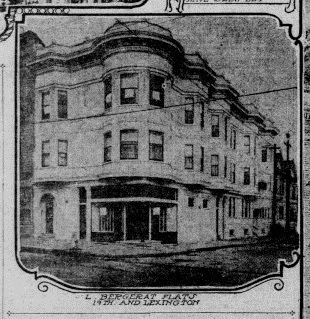
The sidewalks in the photo had just been installed that summer before, as part of a shit-ton of city improvements and construction bonds. Remember, Valencia Street at 19th had been, in 1906, completely and totally fucked by the earthquake. As part of the rebuilding, the Mission District became a destination for working class folks from South of Market who had been made homeless by the earthquake, and so the streets were paved and even more apartments were built.
3. The French guy who owned the land hired a French architect to design the building! So much Frenching at 19th and Lexington!!
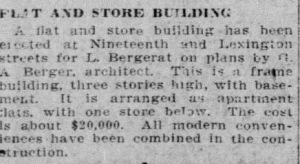
First of all, let’s give G.A. Berger a round of applause for designing such a building (with basement! Bonus applause!).
Gabriel A. Berger Jr was the son of a well-known contractor in the city and studied architecture in France. He was with Everett & Berger architecture firm (Oliver Everett is perhaps most known for designing the City Lights Bookstore building but he was also a socialist), and he designed a few other flats in the Mission.
Speaking of Gabriel A. Berger Jr and his story, to be honest, I had a hard time writing some of the historic aspects of the building that houses the Lex, mostly because sometimes when I am digging around in newspapers and genealogical records, I feel like some kind of historical creep, lurking in other people’s business. But then I realized that voyeurism is kind of an essential Lexington experiences. We’ve been in each other’s business there: I’ve seen your breakups, your phases, who you’ve walked around the corner with, who you’ve gone into the basement with. But in trying to maintain historic accuracy, I will not try to read too far into things, and I will definitely not wonder, based on an 1903 article in the San Francisco Call, whether or not Gabriel A. Berger Jr had an affair with a man who was shacked up on his houseboat in Sausalito and who, while taking Gabriel to the ferry, shattered his knee and then passed out in the boat in the tule reeds. I will not fantasize about turn-of-the-century homoeroticism at all.
4. The French guy who designed the building also had a bull terrier puppy named Scout. How many dogs named Scout have you met at the Lex? Or people?
5. Illegal lady drinking!

In 1911, the Mission was apparently rife with vice. The Police Chief had received reports that saloons all over the neighborhood was serving liquor after hours or without serving food, running gambling halls and – shamlessly! – serving women. It is hard for me to fathom this, but during this time, it was actually illegal for women to be in a saloon unescorted, and they couldn’t order their own drinks. Saloons and restaurants in general were challenging for women to navigate, as even when the rules were followed, it was not ladylike for women to be seen in a bar (or even dining) alone. But the police captain of the Mission District clarified that it was not just immoral but illegal (see copies of the captains orders about female patrons in the stunning collection at the San Francisco History Center of the San Francisco Public Library). Captain Henry Gleeson thus sent a detective and ” a lady” undercover out into the Mission on a late Sunday evening, and together they visited 10 saloons. The tavern at 3464 Nineteenth was one of them.
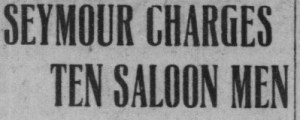
August Pomieczynski was the proprietor of the tavern, and the detective and lady walked right in, ordered liquor at the bar, and drank it. The Call salaciously reported that in each saloon charged, women were in plain sight, just sitting there drinking. Drinking! Liquor! Openly! And talking – sometimes to each other! The reporting – at once breathless and banal – suggests that the women were either prostitutes or didn’t care if they appeared as prostitutes.
Also – the detective and his lady pal (I imagine them kind of like “Moonlighting”) visited 10 saloons in just one evening . And they ended the evening at the Lex! That lady detective is my kind of woman. It was also noted that she ate a sandwich at the one saloon that was operating by the rules and serving food, because, you know, #hangry. And of course, the reports about vice in the Mission all revealed that the police officers in the Mission were profiting from the illegal bunko games (they were in thick with the house, so looked the other way) and several police officers ended up under investigation. But somehow ladies having a Corpse Reviver without a male escort got August Pomiecynski charged with a crime.
6. August Pomieczynski then moved the saloon from 19th and Lexington first to 17th and Castro and then to 18th and Collingwood (right where Toad Hall is now!). There he was later fined $5 for serving “adultered” whiskey. Hats off to you August, you know how to serve people who don’t give a fuck, slutty ladies and bad whiskey drinkers alike.
7. It should be noted that Captain Henry Gleeson, who was in charge of the sting on drinking ladies, ordered a dispersal of a lawful gathering of Socialists after the arrest of anarchist Emma Goldman, who lived on Dolores Street at the time with her lover Alex Berkman. If you have never read Emma’s writings, it is well worth a day spent reading them, especially if it’s a rainy afternoon at the Lexington Club in 1999 and you are 23 and experiencing intense anti-state feels.
8.
![]()
Louis Bergerot died at age 53 in 1913. Mrs. Agnes Moore purchased the saloon in a city auction on May 15th, and was aggressively questioned as to why she — a woman – would want a saloon.
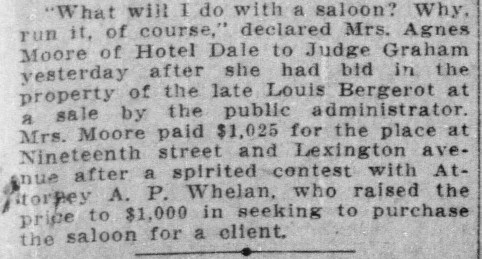
I have not yet found much information on Mrs. Agnes Moore, but the Hotel Dale was a large hotel in the Tenderloin, often hosting union gatherings. It’s not really quite clear why the judge and newspaper reporter were so worked up about a woman running saloon. It was quite common – at least in San Francisco for women to own and run hotels and rooming houses, since that work most closely matched the housework that women were already doing for free in their own homes. And many women ran restaurants and saloons after their husbands were deceased. In fact, in 1912, after August Pomieczynski split, Louis Bergerot got a saloon license for his building by purchasing one from Mrs. Eliza Kramm, who ran a saloon at 957 Mission for a year after her husband died. But our Agnes Moore may have ruffled some manfeathers since she wanted to run the saloon herself, without a dead husband paving the way. Also, how pissed was A.P. Whelan, who probably felt entitled to buy the saloon with his mandollars. Shove it, Whelan!
Also, more Frenching at 19th and Lexington! The city directory from 1914 through 1918 lists a Jules Bonohan (of course the lady who owned the saloon is erased from public records). He was previously a laundryman. Yay for clean sheets!
9. The bar was a “soda fountain” during Prohibition, and given that nice side door, it seems likely that Michael Hannigan, proprietor, was serving ladies moonshine all night long on Lexington Ave. Regarding Prohibition, San Francisco was basically like TL;DR
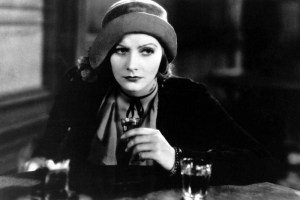
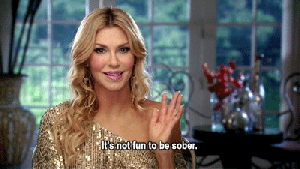
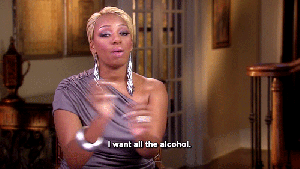




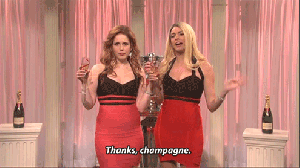
10. By 1933, when Prohibition ended, a Bart Semenza opened the Lexington Buffet, proudly advertising both hot lunch and booths for ladies. God love you, Bart Semenza.
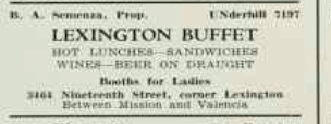
As we saw with August P., serving women openly brings on existential crises for many sectors of society. Outside of formal restaurants, most restaurants were more or less “eating houses” that served food at counters, and they were not always proper for women wanting to preserve their reputation, though of course this differed by race and class. Besides that – a woman eating alone is a big fucking invitation to be asked why you aren’t smiling or to be engaged in non-consensual conversation. I would bet eight thousand double barrel shotguns that a tavern serving women still had men standing around asking ladies if they like dogs or want to see his collection of musical boxes or if she has a beau. So as hangry women started occupying more of the workforce and taking up more public space (and, like, voting) restaurants evolved to serve women who were still wearing the fucking whale-boned skirts and trying to avoid talking to strange men by first adding tables, and then, increasing public invisibility with private dining rooms, booths or boxes, which they kept reserved for women.
So ads like this, ran by proprietor Bartolomew Semenza who, with his wife Mary, ran the Lexington Buffet from 1933 through 1951, were making ladies explicitly welcome by providing them with a proper booth.
ALL YOU CAN EAT AT THE LEXINGTON BUFFET! COME EAT A HOT LUNCH AT THE LEXINGTON! COME QUENCH YOUR THIRST IN A BOOTH AND LET US TAKE CARE OF YOU!
Ok. That was a lot to take in. I kind of need a drink after all of that (hot lunch is tiring; can we get Frenchie to wash the sheets for us?) and because I’m just a lady, so much reading is exhausting…here let me light a cigarette with a — what’s this?
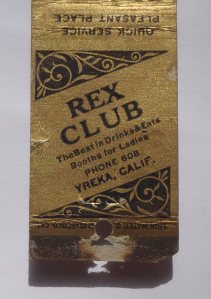
The second half of the decade of 3464 19th is a bit murkier. The bar is listed in telephone directories as the Lexington Club as early as 1960 (did the lighted sign go up then?), and given that the area around the Lex saw more women- and lesbian-owned businesses in the 1970s, I wondered if there was another woman owner in the mix, but there is just one woman listed in directories associated with the Lexington Club, in 1968 through 1971, an Ann Landia T.M. Starr. I can’t find any records for this person, just a T.M. Starr as an arrival to San Francisco on a clipper ship in the 1850s.
Still, I wasn’t looking for the story of a woman bar owner – the Lexington Club has had 18 years with a great woman bar owner. In the historic records, I was looking for stories of queers like myself. Someone who could walk into a saloon and do something that was perhaps immoral or perhaps a reputational risk, and find others who were doing the same thing, and for at least one moment, exhale, have a drink, catch eyes with a friend or a stranger, and feel centered on those geographic coordinates while the rest of the world spins on.
It will be hard without the Lexington Club. But when we walk past the new bar – maybe you’ll go in, maybe you’ll spit in the street, maybe you won’t walk past because the changing Mission isn’t part of your daily geography– we might remember that we made the Lex what it was, but it seems that we also had help from the ghosts of autonomous naughty women, and the men who loved them, that lurk within the walls. Keep your eyes and heart open and maybe we’ll find another building with even naughtier ladyghosts. Let’s raise a glass, or a quartz, to the Lex. Farewell, friend.
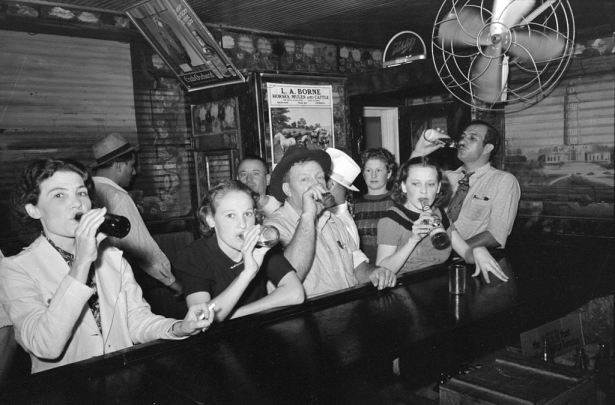
Raceland, Louisiana, 1933. Photo by Russell Lee for Farm Security Administration/WPA.
Originally published on historyparty.wordpress.com. Republished WITH PERMISSION MOTHERF*CKERS.



This satisfied all my nerdy city history desires. Thank you!
This was great! <3
Woooooooooow, this article is amazing.
I’ve only been the Lex once because of the same feelings you mention: “I was easily intimidated by queer women who lived openly.”
And I had to get drunk BEFORE arriving, so I’d have the nerve to go to my first lesbian bar by myself
Fascinating herstory, thanks!
Great article. I love finding out the history of the buildings we interact with in the present day, and learning about the personalities that touched these places in the past.
This is amazing, thank you!
I think the Rex Club that matchbook is from is still there, although probably a little different these days. Doubt they have booths for ladies…
Excellent article Ivy. Great job. Loved it. I’ll always have the memory of peeing in the hole in the floor in that basement…
lol
Oh Lex, where no one would speak to me…